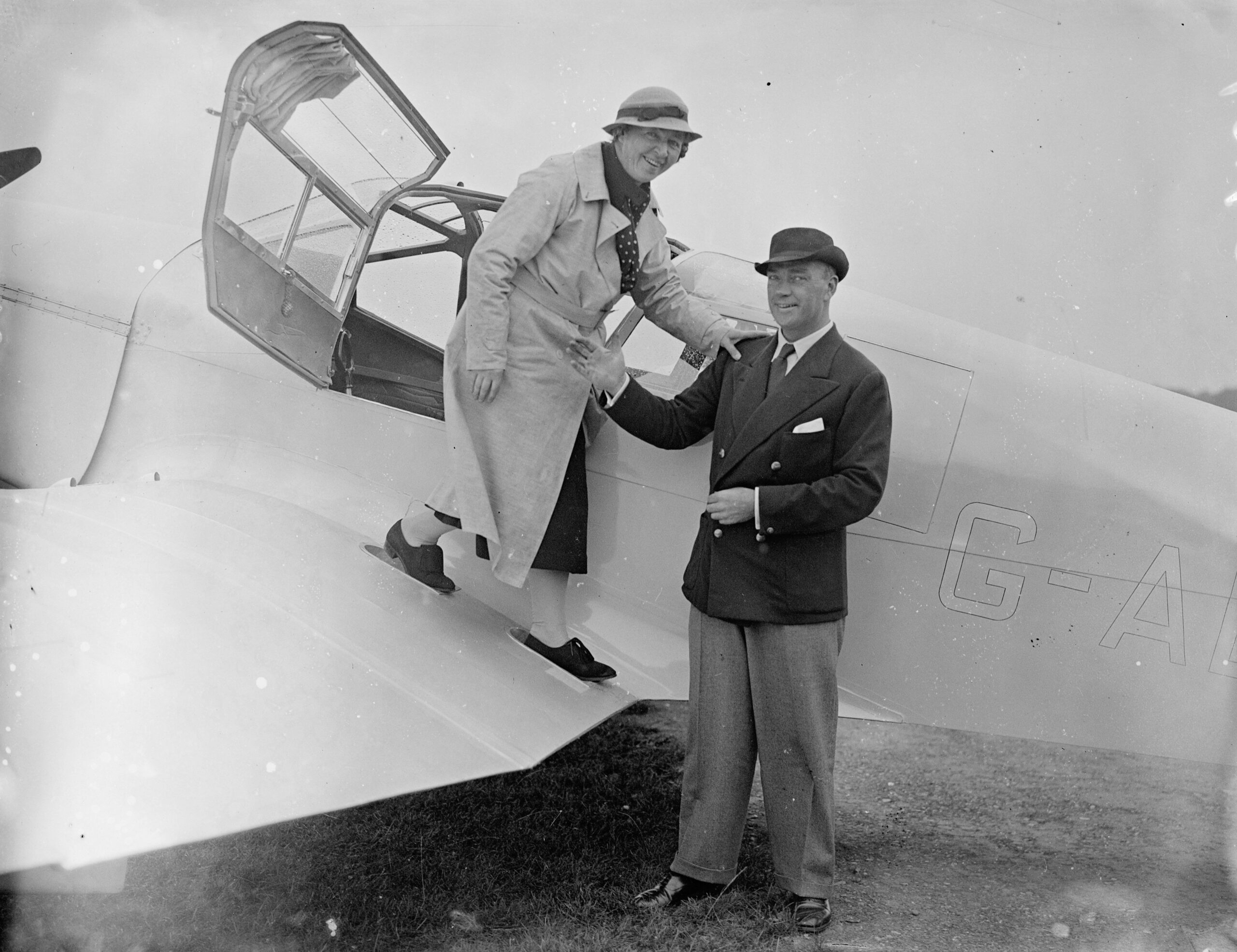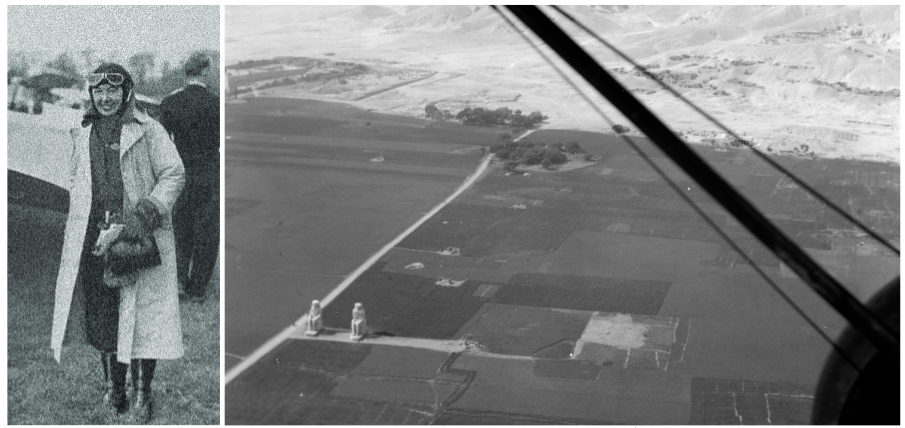By Tom Dillon

Described as ‘Ireland’s airwoman No.1’, Lillie Dillon from Listowel, Co. Kerry, was a pioneer of Irish aviation. Living at a time when societal attitudes imposed many restrictions on women, her exploits throughout her colourful life made her a remarkable individual. She was born as Elizabeth Mary de Courcy Dillon on 27 October 1880; her father, John T. Dillon, was a dispensary doctor, while her mother, Ann de Courcy, hailed from a local gentry family of racehorse-owners. In her native town Lillie is still remembered for landing her plane on the famous racecourse on the opposite side of the river from her family home.
The Dillon residence in the Square operated partly as the medical practice of her father and her brother Henry. This background may well have inspired Lillie to volunteer during the First World War. After nursing work with the Red Cross in Kingstown (Dún Laoghaire), she saw service in London and France as a motor driver, having joined the Women’s Legion on its foundation in 1915. Like so many other endeavours during her life, this work was against convention for a woman, but to support the war effort Lillie and countless other female drivers got behind the wheel and ventured into the danger zone to ferry casualties back for treatment—sometimes under enemy fire.
Her father became the owner of one of the first cars in Listowel around 1914 and perhaps this inspired Lillie’s lifelong interest in motoring, which culminated in 1934 in her participation in the iconic Rallye Automobile de Monte-Carlo in her Fiat motor. A well-educated woman, Lillie travelled extensively across Europe, knew several languages and was a keen skier. Visits to Switzerland were regular, and over the years she broke several bones on the ski slopes.
LEARNED TO FLY IN HER FIFTIES
In her fifties Lillie learned to fly at the Cork Aerodrome in Fermoy, with E.J. Dease as her flying instructor. She obtained her Irish licence in 1934 and was the first woman member of the Irish Aero Club. Within two years she had crossed the Irish Sea fifteen times in her own aircraft, which she purchased in January 1935. A shy and gentle character, Lillie was one of the first Irish women to possess their own plane. She chose a British Klemm Swallow, a two-seater monoplane with the registration EI-ABD, being well known at air shows and in races. Dubbed ‘the safest aeroplane in the world’, this model with its Pobjoy engine cost £695 and was capable of reaching a top speed of 110mph. On 27 March 1935 it was the first ‘flying machine’ to land on the Aran Islands. With Lillie and E.J. Dease on board, the aircraft took off from Galway and made history when it touched down on Inish more, landing on the strand near Kilronan.

LADIES’ CUP-WINNER IN EGYPT
Two years later, in 1937, came Lillie’s crowning achievement as an aviator when she entered the Ladies’ Cup at the Round-the-Oases air rally in Egypt. Competing in her Klemm Swallow aircraft, she had an extra fuel tank fitted to increase its flying range. The course, which was 1,300 miles long, went from Cairo to Luxor on the River Nile and back to the Egyptian capital. The first leg of the five-day rally saw the 54 competitors fly to Aswan, where the tail-skid of Lillie’s aircraft was smashed on landing. Fortunately there was time for its repair, as the following day was scheduled for sightseeing at the Valley of the Kings.
Further trouble ensued in the race, however, when Lillie was forced to land her aircraft in the Sahara Desert, this time owing to lack of oil. She sat for several hours in the plane while her co-pilot set off on foot for help. Luckily, another pilot saw that they were in trouble and helped get their plane back into the air. Despite this delay, Lillie was the third flyer to arrive back at the starting line and claimed the Ladies’ Cup and prize. Her victory was widely celebrated in Irish aviation circles and received much attention in the Irish and world press.
KING’S CUP AIR RACE
The following September, she took part in the King’s Cup air race with Captain T. Neville Stack as co-pilot—again making history as the only female competitor in the race. London-born Neville Stack was a well-known aviator and it was through his influence that Lillie learned to fly. The race was the first time that the Irish Free State was represented in an international air race and it carried a prize of £1,000 to mark the British coronation that year.
Taking place over two days, the race involved 30 planes with pilots from across the world covering the 1,442-mile route from Hatfield Aerodrome near London to Scotland and Belfast before returning to the starting point via Dublin and Bristol.
Lillie and Neville Stack flew a Percival Vega Gull aircraft with a top speed of 170mph. The pair were assigned the unlucky number 13 as their entry for the race, and photographs were staged for the press with the celebrated Kerry woman beside the ill-fated digits. Sure enough, bad luck did strike: having taken off, Lillie was forced to land again with engine trouble. The mechanics worked quickly and only ten minutes were lost, but ultimately this loss of time saw her plane eliminated from the competition. News of her involvement in the King’s Cup was widely reported in the media at home and abroad, and the adventurous Irish airwoman featured in British Pathé film clips of the race.
After the King’s Cup, Lillie toured Ireland and Britain, taking part in air shows such as the Irish Aviation Day in the Phoenix Park and the Eastbourne Air Show, and attending the inaugural Northern Ireland Aero Club rally at Newtownards. She also gave a lecture in Dublin entitled ‘She Flies Through the Air’ and revealed her thoughts on flying as a most ‘fascinating’ hobby.
AVIATION CELEBRITIES
Lillie met Colonel Charles Lindbergh at Baldonnel in 1936 and was reportedly the only woman to acquire his autograph. Lady Heath likewise became an acquaintance when she was taking flying lessons at Kildonan Aerodrome. Local folklore in her native Kerry once held that Lillie paid Lady Heath—who also had family connections to the Listowel area—to perform loop-the-loops and nosedive with her plane on one occasion over the nearby seaside town of Ballybunion.
Another aviation celebrity was Alex Henshaw, who received a letter of congratulations from the Kerry woman after his record four-day flight from England to Cape Town. Attached to the letter, sent a day after his return, was a four-leaf shamrock for luck. Seán Ó hUadhaigh, first chairman of Aer Lingus, stated in 1938 that Lillie Dillon had been the only Irish pilot to show the ‘EI’ designation extensively abroad up to that point in time. Her attendances at air shows in Dinard, Luxembourg, Brussels, Carlisle, Rochester, Dublin and the Ulster Rally were among many destinations clocked up.
It was on a return journey to London from York in June 1937 that Lillie was involved in an aircraft accident which left her in shock but unhurt. She was a passenger in a plane piloted by a Mr Crowe when they were forced to make an emergency landing on a farm outside the village of Grafham in Cambridgeshire. As the plane came in to land, it clipped a hedge, turning the nose of the aircraft into the ground. The two passengers escaped without harm but the plane was wrecked.

SECOND WORLD WAR
Just before the outbreak of the Second World War, Lillie was among 100 pilots of the Royal Aero Club who travelled across the English Channel to Deauville for an air rally. It was not her first time to visit Franceas a pilot, as two years earlier she was part of the British team that claimed the team event at the Paris International Air Rally. The clouds of conflict were gathering, however, and had it not been for the war the trajectory of her fame in the aviation world might well have reached further heights. Her airplane was pressed into service with the Royal Air Force, while Lillie also mobilised to offer her assistance. Alongside thousands of other women from all walks of life living in the British capital, she volunteered to serve with the London Auxiliary Ambulance Service.
She drove ambulances during the Blitz—dangerous work, as German bombs rained from the skies night after night. She also assisted with air-raid precautions and helped deal with casualties after Luftwaffe bombing runs. Her unit, which operated on twelve-hour shifts, was based in a sandbagged shelter in Greenwich, where the veteran pilot wore her flying kit to keep warm on bitterly cold nights.
Lillie was also an early member of the Women’s Air Wing, which was established to aid the Royal Air Force. At 60 years of age, she completed her training with the Royal Aero Club and was awarded her aviator’s certificate in January 1940. After the war her plane was returned to her, but in 1950 it was cancelled from the Irish register. Six years later, Lillie emigrated to Australia, where she lived with her sister, Annie, and her husband, Colonel Dowden. On their deaths shortly after, she inherited their home in Perth and their car, which Lillie insisted on driving until the day she died, 6 August 1963. She passed away after returning from morning Mass and is buried in Karrakatta Cemetery, Perth.
Throughout her remarkable life, Lillie Dillon transcended the repressive gender-based attitudes of the time. As a motor driver in two world wars, a thrill-seeker on the ski slopes and a trail-blazing aviator as a 50-something in the heavens, she was one of the most remarkable Irish women of the twentieth century.
Tom Dillon is a historian, educator and writer from Listowel, Co. Kerry.
Further reading
D. Blake, Daughters of Ireland: pioneering Irish women (Dublin, 2015).
